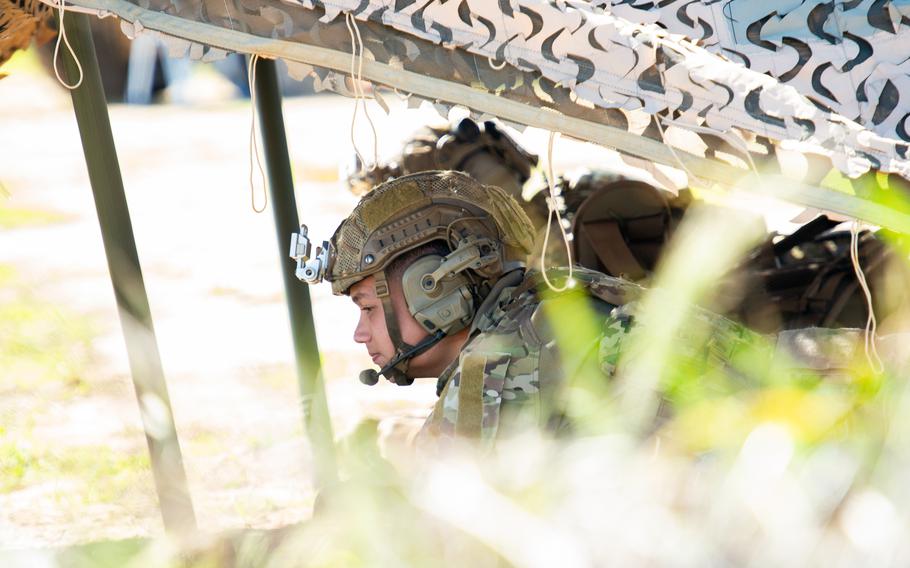
Army Rangers from the 2nd Ranger Battalion, 75th Ranger Regiment take cover while controlling a drone swarm during a demonstration March 5, 2024, during Project Convergence at Camp Pendleton, Calif. The Army-led Project Convergence is an experiment to bring all the military services together to link their intelligence-gathering sensors to all their offensive and defensive fires capabilities and test new age technology that the Defense Department hopes to field to the force. (Corey Dickstein/Stars and Stripes)
CAMP PENDLETON, Calif. — Army Rangers send a swarm of small drones out over the Marine Corps base in Southern California in search of potential targets. Off the coast, Navy destroyers stand by ready to fire, if called upon.
Meanwhile, Marine logisticians just off the shore move supplies onto land using autonomous boats to transport gear close to the coastal base and unmanned drones to deliver the equipment to troops on land.
Farther away, Air Force fighter jets patrol desert training ranges near Nellis Air Force Base in Las Vegas in search of enemy aircraft. And at White Sands Missile Range, N.M., Army special operators conduct secretive reconnaissance missions, quietly closing in on potential adversaries to gather intelligence.
These training operations across the western United States in recent weeks were linked together by top Army leaders working from a command center at Camp Pendleton, connecting those troops, their intelligence-gather sensors and their weapons to form a so-called “kill web,” as part of broad experiment to share targeting information and other data at breakneck speeds among all U.S. military services.
The experiment, known as Project Convergence, was the largest effort yet to pull the services together under a single command and control apparatus to choose the best weapon in the Pentagon’s arsenal to destroy a target quickly. Dubbed the Combined Joint All Domain Command and Control, or CJADC2, Pentagon leaders, including Defense Secretary Lloyd Austin, have called it the Defense Department’s top technology priority, and plan to spend some $1.4 billion on the program next year, according to its fiscal 2025 budget proposal.
Military leaders believe connecting all the military services sensors — from satellites in outer space to aircraft in the skies and from ships at sea to infantrymen on the front lines — in a communications network is the best way to fight, should U.S. troops find themselves in a conflict with near-peer rivals such as China or Russia, which have spent heavily in recent years on new military technology.
In one instance during the experiment this month, a Marine F-35 stealth fighter discovered an enemy target, relayed the information to an Air Force battle management node and an Army artillery battery blasted the target with a missile — all in seconds. That kind of success — rare in a military where the branches speak with jargon unique to their own troops and use weapons systems developed specifically for their branch — proves CJADC2 can work in future conflict, said Lt. Gen. Ross Coffman, the deputy commander for Army Futures Command, who helped lead the experiment.
“There’s no Army fight. There’s no Marine Corps fight,” Coffman said March 5 at Camp Pendleton as Project Convergence prepared to move its 2024 capstone experiment from a maritime fight at the Marine base to a desert operation at the Army’s National Training Center at Fort Irwin, Calif., some 150 miles northeast. “There’s a joint fight. … Each of our services are extremely capable. I would say the best in the world. When those five services come together in exercises like this, we form a fist, and that fist delivers an incredible punch.”
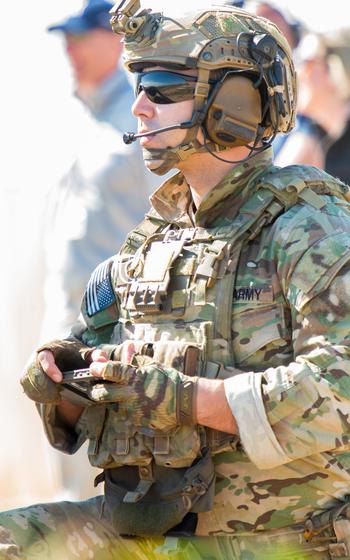
An Army Ranger from the 2nd Ranger Battalion, 75th Ranger Regiment controls a drone swarm during a demonstration March 5, 2024, during Project Convergence at Camp Pendleton, Calif. (Corey Dickstein/Stars and Stripes)
The experiment at Camp Pendleton and Fort Irwin from Feb. 23 through March 20, included two distinct focus areas, both aimed at transforming how the military fights.
The initial phase at Camp Pendleton focused on the ability to move massive amounts of data — the intelligence collected by military sensors — between the U.S. services and several allies, including the United Kingdom, Australia and New Zealand, and linking together offensive and defensive firing capabilities.
The second phase at NTC focused on human-machine integration in combat formations — adding small airborne drones and ground robots into the Army’s front-line fighting units to expand firepower and reduce risk of harm to the troops closest to the enemy.
The Army launched Project Convergence in 2020 as a small experiment aimed at drastically reducing the time it takes to attack a target after identifying it on the battlefield. Futures Command worked to link various Army sensors across the battlefield — such as drones, radar systems and technology in soldiers’ hands — to command-and-control nodes outfitted with artificial intelligence designed to rapidly determine what the target was and what weapon would best eliminate it. Coffman, who also led the 2020 version of Project Convergence, touted at the time his team’s ability to cut targeting processes from tens of minutes to tens of seconds, in some cases.
In three subsequent iterations of Project Convergence, the Army has continued to shave time off its targeting processes, Coffman and other officials said. This year, processing times to find a target, verify it and strike it improved since the initial experiment in 2020 was held at Yuma Proving Ground in Arizona, said Alex Miller, who serves as the top technology adviser to Gen. Randy George, the Army’s chief of staff. Miller and Coffman declined to provide specifics about targeting timing in the experiment, citing concerns about revealing too much to adversaries.
“We did see things that took minutes of very human-central processing go down to seconds because the workflows were entirely automated,” Miller said. “So, what we did see is from a sensor to someone who could affect a target — two orders of magnitude reduction at times. And it was pretty awesome.”
The Army gradually expanded Project Convergence in recent years, adding other services to its second major experiment and several allied militaries later. This year, Project Convergence has grown to encompass a variety of experiments built into training exercises in the Indo-Pacific Command area of operations and the European theater, Coffman said. It will continue later this year with another exercise in INDOPACOM.
Coffman described the program going forward as a continuous “campaign of learning.” The experiments this month served as the capstones for Project Convergence in 2024, which the Army had planned to pour some $90 million into this year, according to service budget documents.
“We started very small, proving tech [in the initial Project Convergence] and now today we’re talking across services, we’re passing data across services, and proving that we can work together to protect through defensive fires and affect through offensive fires,” Coffman said.
The project used a Joint Track Management Capability data bridge built by the Missile Defense Agency to link all the services’ components together on a single network, he said. The bridge allowed the services and allies to pass data back and forth at rates the Pentagon had never attempted previously.
“This bridge absolutely allowed us to pass information from multiple sensors to multiple shooters, so that an Army sensor passed data to a shooter in every service, and the other services’ sensors passed data to all the other services,” Coffman said. “It worked magnificent. It was able to pass the amount of data that we have not seen before … ncreasing it tenfold, and it absolutely was able to pass that data and get it to the right shooter.”
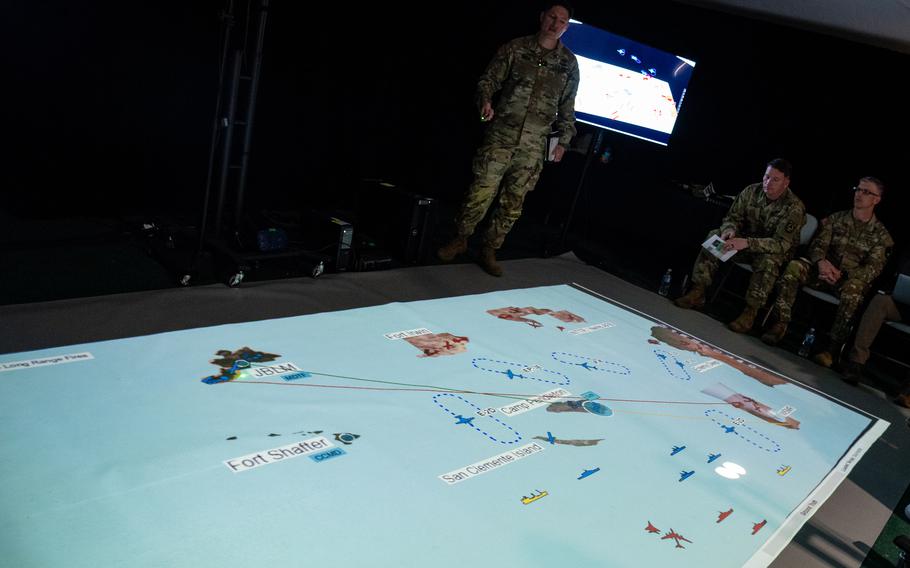
Army Maj. John Donaho, a capability integrator team leader for Joint Modernization Command, top left, explains the scenarios and battlespace involved in the Army’s 2024 Project Convergence capstone event on March 5, 2024, at Camp Pendleton, Calif. ( Corey Dickstein/Stars and Stripes)
Fighting at ‘machine speed’
Inside a military tent, Army Maj. John Donaho stands before a large projection of the expansive battlespace and military assets involved in the first phase of Project Convergence. The battlespace spreads out from Camp Pendleton, the experiment’s “nerve center,” as far east as Joint Base McGuire–Dix–Lakehurst, N.J., and as far west as Australia, said Donaho, who leads a Joint Modernization Command capabilities integrations team for Army Futures Command.
The massive battlespace was meant to represent the challenges presented by fighting a conflict in the Indo-Pacific Command area of operations, which spans nearly half the globe’s land area and the Pacific Ocean. The region is the Pentagon’s top security priority, highlighted by China, which is considered the top U.S. challenge as it expands its military and conducts increasingly destabilizing operations in the region, according to Adm. John Aquilino, the commander of INDOPACOM.
At Project Convergence, military leaders worked to ensure that a commander at Camp Pendleton had nearly real-time control of his forces across that huge swath of the globe — from artillery batteries in northern Australia and at Joint Base Lewis-McChord, Wash., to Navy destroyers and littoral combat ships operating in waters between Hawaii and California, and aircraft flying throughout the region, Donaho said. The key is the automation brought by artificial intelligence and machine learning that allow any of those troops across the globe to relay information quickly to the commander who can then make a decision with that data, the major said.
There are multiple reasons why the Pentagon wants to hasten its targeting practices to allow commanders to make those decisions “at machine speed,” Donaho said. In some cases, targets might only present themselves for a small window of time.
“So, if something’s only there for 10 or 20 minutes, we don’t have time for 15 telephone operators along the way to pass that message up, get a decision, and then pass it all the way back down to the person who is then tasked to hit that red button to make the rocket go boom,” Donaho said March 5 at Camp Pendleton.
But Pentagon leaders also believe by speeding up the ability to share targeting information and other data between all services operating in a battlespace, it will also save them precious resources, including expensive missiles, which defense leaders fear would be at a premium in the early days of a conflict with a power competitor such as China.
Without a common operating picture among the services through a program such as CJADC2, the separate branches might end up “double targeting or triple targeting” an enemy asset that reveals itself, said Vice Adm. Michael Boyle, the commander of the San Diego-based 3rd Fleet. Boyle led the Navy’s contributions to Project Convergence.
“If we can’t connect ourselves together, we’re going to all build individual stovepipe plans,” Boyle told reporters March 5. “But if we can connect together, then we can draw from a single magazine across the joint force. We don’t have unlimited magazines … so this enables us to pick whatever magazine we need to pick from.”
The technology on display at Project Convergence was not limited to the efforts to connect sensors and shooters and share data across all the military services. Coffman said the Army has also used the platform to test the latest technology it hopes to bring to its formations in the coming years, including self-driving tactical vehicles, small drones and robots capable of firing machine guns or other weapons.
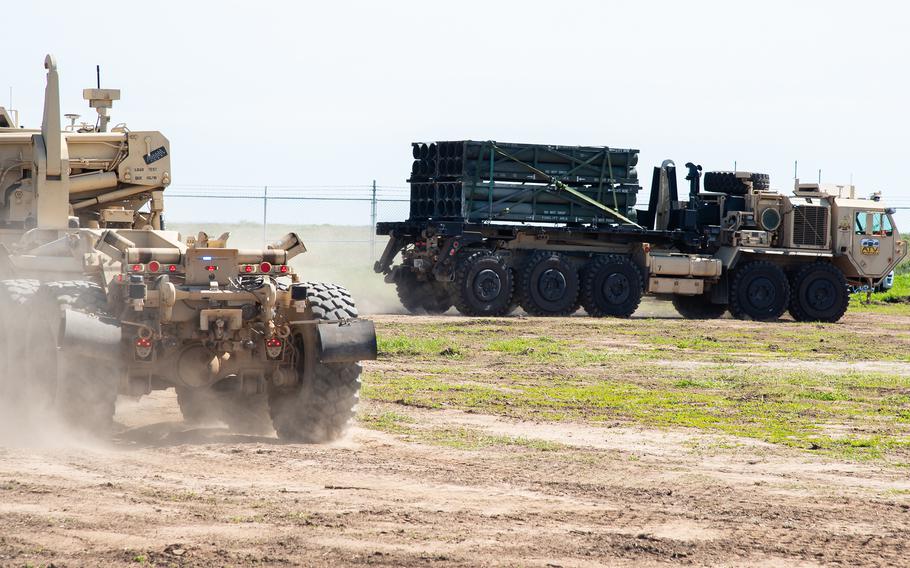
Self-driving tactical vehicles move themselves during a demonstration of emerging technologies on March 5, 2024, during Project Convergence at Camp Pendleton, Calif. (Corey Dickstein/Stars and Stripes)
‘Machines before humans’
A four-legged robot resembling a dog marches through the streets of a small village built on NTC’s vast desert training grounds. The semi-autonomous ground drone, which weighs about 110 pounds, is built to provide a soldier with a new means of reconnaissance — “acting as their eyes and ears” on the ground, according to Army officials.
The robotic dog can run about three hours and span distances beyond 6 miles, according to its manufacturer Ghost Robotics. The robot can move through water, climb stairs and send live 360-degree imagery back to its operators. For troops serving on the frontlines, it offers them the ability to stay hidden as it searches potentially dangerous areas, officials said.
The Army has been experimenting with robotic dogs and other ground robots at Fort Moore, Ga., in recent months. But at Project Convergence, it used the new technology for the first time in a major combat training operation. During the experiment, soldiers from several units, including the 82nd Airborne Division, the 3rd Armored Corps and the 316th Cavalry Brigade, tested dozens of robotic and autonomous machines as they fought their way into NTC’s training grounds.
While soldiers have been using small aerial drones at NTC and in other training and combat environments for years, ground robotics have lagged behind their airborne counterparts, said Miller, the tech adviser to the Army chief of staff.
“We’ve learned that ground robotics is a super hard problem,” he said, comparing it to Tesla and other car manufacturers’ long-running quest to develop safe self-driving cars.
But Army officials believe ground robots, like small unmanned aerial systems, are critical to building a force that can survive in large scale combat operations against an enemy with similar firepower to U.S. forces.
In such an environment, Coffman said, it will be important that American troops make initial contact against enemy forces “with the machines before humans.”
“That is ground and air robots that can move forward to identify where the enemy is, and if something goes … terribly wrong and the enemy identifies [the robot], then they have shot, and now we know where they are and how we can [attack] them,” the general said. “Everyone on the battlefield can then move to a position of relative advantage, rather than anyone being shot” in that initial firefight.
The Army chose to move the training midway from Camp Pendleton to Fort Irwin to test its robots in its most demanding environment, where the desert routinely wreaks havoc on the soldiers who train there each month and their equipment.
If the robots and human soldiers can work together on NTC’s austere grounds, they can likely operate in most any environment to which they are sent, Coffman said.
George, the Army chief of Staff, said Project Convergence might help the Army hasten its pace at integrating some robots into its traditional combat units.
“This is a fast-moving train,” George told reporters. “It needs to be. We have a real sense of urgency to get after this.”
The Army will continue experimenting with robots as it moves forward into the next phase of Project Convergence, officials said. The service plans to conduct experiments under the Project Convergence umbrella in the summer during the Valiant Shield 2024 wargames in the INDOPACOM region. And the service requested some $73 million to continue Project Convergence in fiscal 2025.
“The lessons we’re learning are going to be applied in the next Pacific exercise, then in Europe. We’re stringing these lessons learned together with real exercises … so we can continually improve,” Coffman said. “It’s worth it. It’s worth every penny. The readiness of the joint force and the partnership with our allies is invaluable. When called upon, the women and men of this nation, women, men of other nations will fight side-by-side, preserve liberty, and the cost of this … experiment is worth every penny to ensure that can happen.”
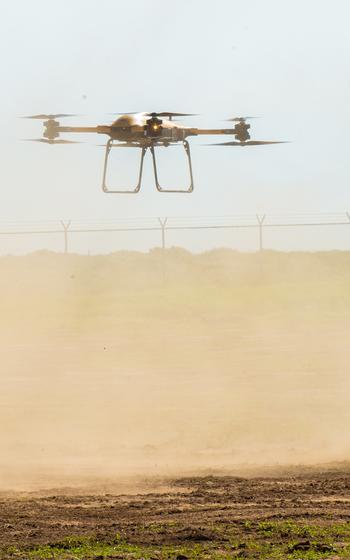
A Tactical Resupply Vehicle-150 semi-autonomous logistics drone takes off at Camp Pendleton March 4, 2024, during a demonstration of emerging technology as part of the Army’s Project Convergence. The drone — some of which have been purchased by the Marine Corps — can carry up to 150 pounds of gear and can fly about 40 miles. (Corey Dickstein/Stars and Stripes)